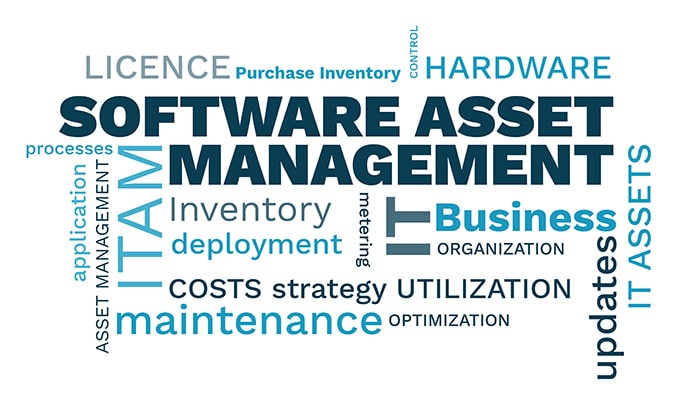Business, meet SAM and ITAM

Why your business needs Software and IT Asset Management
SAM (Software Asset Management) is the process that ensures effective management, control and protection of your organization’s software. It includes having the correct software licences, number of licences, and versions, and ensures you’re not paying for software that you don’t need or use; for instance, there’s no sense paying for 50 Microsoft Office licences when you only have 35 employees.
What’s ITAM?
ITAM (IT Asset Management) is a process that keeps track of your entire inventory to ensure you have the correct software and hardware assets for your organization at all times. For instance, when a new employee starts, ITAM tells you what hardware and software you have available for the new employee, and you can save money by buying only what you require.
How are SAM and ITAM related?
ITAM covers all IT assets (servers, hardware, software) and is the umbrella over SAM (software). ITAM also covers SAMs brother, HAM (Hardware Asset Management).
ITAM tracks and inventories your hardware and software assets. Its benefits include ensuring printers don’t go missing, everyone has the correct software installed, laptops that go home aren’t forgotten, and PCs get replaced every four years.
SAM manages and optimizes software applications. Its benefits include knowing what software is being used by whom, the version, compliance, and ensuring you’re legally entitled to run the software and aren’t overpaying.
What are the dangers of not having SAM?
There are two main dangers of not having a SAM system in place:
1. Overpaying for software licences (throwing away money):
This can occur when people don’t spend the time to accurately count the number of licences against actual usage. For example: “I have 35 employees, so we need 35 Adobe licences,” when, in reality, only 20 employees ever use the software.
2. Not paying for software you’re using (stealing):
This can occur when there are not enough licences for employees to use, which encourages “software sharing.” This can come at a heavy price with a headache-inducing vendor software audit. If you have 50 Microsoft Office 365 users who “share” 20 licences, then when Microsoft comes knocking, they will want payment for the missing licences now and for past usage. To learn more about Microsoft Office 365, read our post, “Hey! You! Get into my cloud: Microsoft Office 365.”
Even when you think everything is under control, sometimes it’s not. You can have 50 users of XYZ software and 50 licences, but are using the wrong software version for these licences. Under these circumstances, you may not only be paying for software you’re not technically using, but also making yourself vulnerable to an audit for the version that you do use.
Where do software audits come from?
Unsurprisingly, software audits come from the biggest vendors (Microsoft, Adobe, SAP, Autodesk, Oracle, HP and IBM). Some years, some vendors are more aggressive than others.
Audits can happen when these vendors conduct routine checkups on their customers, follow up third-party reseller suggestions, getting tips from disgruntled staff, and sometimes even as sales tactics to get more business from someone who hasn’t spent much lately.
The worst part is software audits are increasing and show no sign of slowing down. As reported in Flexera Software’s report, The State of the (Software) Estate: Waste Is Running Rampant in Enterprises, 2016 Key Trends in Software Pricing & Licensing Survey Report.
Is my company at risk?
Unfortunately, every company that uses software is at risk. Software vendors know small- to medium-sized businesses don’t have the manpower, skills, or ability to understand complex licencing rules. They also know that smaller businesses don’t have the time or resources to spend on a long, drawn-out audit and will often settle early.
What can my company do?
The best thing your organization can do is prepare before being audited. I’ll cover some steps to take before and after an audit starts in my next and second SAM post on Tuesday, April 17. Stay tuned!
You can also join me on Tuesday, May 1, 2018 for my webinar, “Software Asset Management: What it is and what you need to know.” Registration opens soon. Check our website and social media for updates on registration.
If you have any questions about SAM or ITAM, you can contact us by email at sales@365tech.ca or call 204-488-3655.




